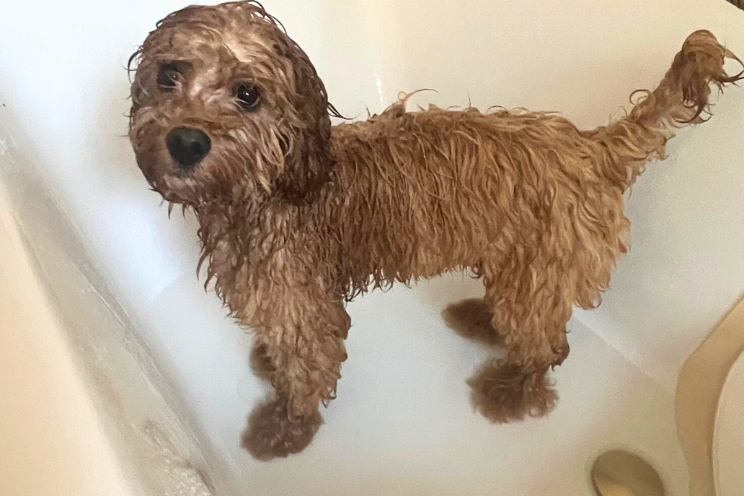
Step-by-Step Guide to Bathing a Puppy
Share
Bathing a puppy for the first time can be an exciting yet challenging experience. Puppies are naturally curious, and introducing them to a bath requires patience, preparation, and the right techniques. A proper bath not only keeps your puppy clean but also promotes healthy skin and coat. Follow this step-by-step guide to ensure a stress-free and enjoyable bath time for your furry friend.
Step 1: Gather Supplies
Before you begin, gather all the necessary supplies to make the process smooth and efficient. Here’s what you’ll need:
- Puppy-friendly shampoo (avoid human shampoo as it can be too harsh on their skin)
- Lukewarm water (not too hot or too cold)
- A small cup or jug
- A wash-time bath barrier
- A non-slip mat
- Soft washcloth (for cleaning the face)
- Towels (for drying afterward)
- Brush or comb (to remove tangles before and after the bath)
- Dog treats (to reward good behaviour)
Step 2: Fit Your Wash-Time Bath Barrier
The wash-time barrier creates a small area in your bath for your puppy to provide a sense of security and prevent unnecessary movement. Ensure the room is warm and draft-free to keep your puppy comfortable. Place your barrier in your bath before you put your puppy in.
Step 3: Brush Your Puppy’s Coat
Before bathing, gently brush your puppy’s coat to remove loose fur, dirt, and tangles. This step helps prevent matting and makes it easier to lather and rinse the shampoo.
Step 4: Prepare the Water
Use lukewarm water - test the temperature with your wrist or elbow to ensure it is neither too hot nor too cold. Using a shower over the bath is the best way we have found however if this is not possible, fill the bath up keeping the water at a comfortable level to prevent your puppy from feeling overwhelmed.
Step 5: Introduce Your Puppy to the Water
If your puppy is nervous, let them explore the bath area before getting wet. Slowly place them in the water and reassure them with a calm voice and gentle stroking. Offer treats and praise to create a positive association with bath time.
Step 6: Wet Your Puppy’s Coat
Using a small cup, jug or shower head, gently wet your puppy’s fur, starting from the back and working towards the legs and chest. Avoid pouring water directly over their head to prevent water from getting into their eyes and ears.
Step 7: Apply Puppy Shampoo
Pour a small amount of puppy shampoo into your hands and lather it gently over your puppy’s body. Massage it into their coat, paying special attention to dirty areas like their paws and belly. Avoid getting shampoo near their eyes, ears, and mouth.
Step 8: Clean the Face Carefully
Use a damp washcloth to gently wipe your puppy’s face, avoiding direct contact with the eyes.
Step 9: Rinse Thoroughly
Rinse off all the shampoo using clean, lukewarm water. Ensure that no residue is left behind, as leftover shampoo can cause irritation. Start from the back and work your way down, avoiding the head until the last step.
Step 10: Dry Your Puppy
Once fully rinsed, wrap your puppy in a soft towel and gently pat them dry. Avoid vigorous rubbing, as it may tangle or damage their fur. If your puppy is comfortable with it, you can use a low-heat setting on a blow dryer, keeping it at a safe distance to prevent overheating.
Step 11: Brush and Reward
After your puppy is mostly dry, give them a gentle brushing to prevent tangles and keep their coat looking neat. Reward them with treats and praise to reinforce a positive bath time experience.
Additional Tips for a Successful Puppy Bath
Bathe your puppy as needed – Puppies don’t need frequent baths; once a month or when they get particularly dirty is usually enough.
Use positive reinforcement – Treats and praise will help make bath time a positive experience.
Be patient and gentle – Some puppies may be fearful at first, so take it slow and reassure them throughout the process.
Check ears and nails – While bathing, check your puppy’s ears for dirt and trim their nails if necessary.
Avoid getting water in the ears – Use cotton balls or be careful when rinsing to prevent infections.
By following these steps, you can make bath time an enjoyable bonding experience for both you and your puppy. Over time, your puppy will grow accustomed to baths, making the process easier and stress-free.
